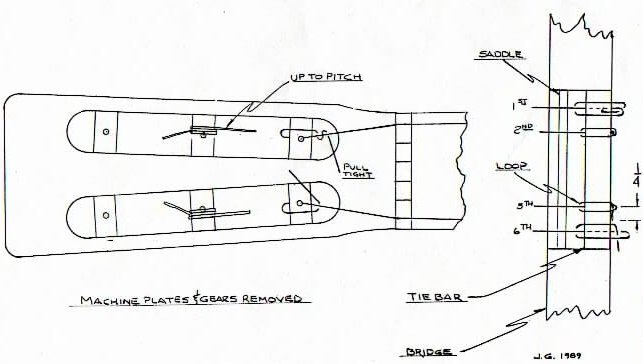
Last Update: 1/10/00
A Guitar Stringing Method
By John Gilbert
After years of observing the different methods of putting strings on a classical guitar, I have reached a conclusion: One system appears to have a definite edge over the others. It is neat-looking, safe, and functional. At the bridge I use a different approach for the plain (1st, 2nd, and 3rd) strings and the wound strings.
First, I burn (melt) a ball on one end of the plain strings. This ball needs to be about 1 ½ to 2 times the diameter of the string. Just hold the last inch or so of the string straight up and hold a burning match just above it. As soon as the small ball forms, remove the match, but continue to hold the string is an upright position until the ball becomes translucent. By doing this, the ball won't deform or become brittle.
Now look at the bridge drawing . You'll see how the plain strings are fastened to the bridge tie-bar. Practice doing this. As you pull the string tight, push down on the ball so it ends up just slightly higher that the tie-bar. When fully tightened, the plain strings will look like the second string in the drawing.
Take a look at the drawing again, and you'll see that the wound strings are tied on slightly differently from the plain ones. The tail of the wound strings should be no longer than a quarter of an inch. Also, as you bring the strings up to pitch, push down on the loop that goes under the string at the front (saddle side) of the tie-bar. This will prevent the 4th (D) and 5th (A) strings from breaking at the bridge. When properly tied, the bass strings will look like the 5th string in the drawing.
Now, to tie the other end of the strings to the tuning machines. If you take a look at the head drawing, you will notice that the plain strings are wrapped twice around themselves, but the wound strings only need to be wrapped once. It's important to pull the strings taut when tightening the string because you want as few turns as possible on the roller. The reason for this is to eliminate the stretching that goes on at the roller as the string is tuned.
Note, too, that you should wind the string to the outside. You can't damage anything that way, but you can cause problems by winding to the inside.
The proper sequence to fasten the strings is first, second, third, sixth, fifth, and fourth. Doing it this way gives the trebles a chance to stretch and seat in while you put on the basses. Also, you get in your own way if you work from, say, the fourth string to the sixth. Try it, and you'll agree.
One last bit of advice: You should protect the area behind the bridge whenever you re-string, no matter what method you use. For this, I recommend a piece of stiff cardboard about one inch by three inches. You can retain it to the guitar face with masking tape. If you put several layers of tape on the cardboard, you'll always have a clean, sticky piece of tape to use, no matter where you are. By using this cardboard, you lessen the possibility of having a string slip and putting an ugly welt in the guitar face. Keep it in your case string compartment.
